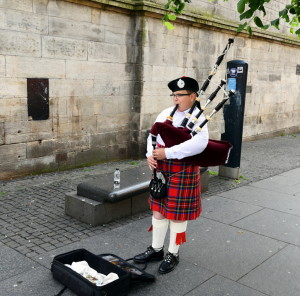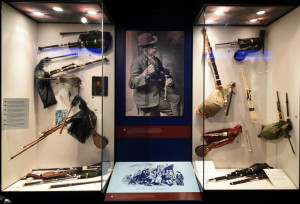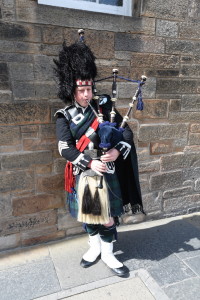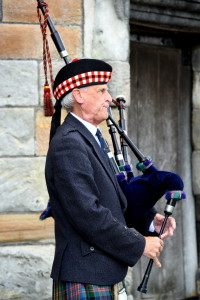Everywhere you go in Scotland, you hear the hum, whine, and drone of bagpipes. In my first couple of weeks here, I’ve probably seen at least a dozen different pipers, ranging from a teenaged lass on Edinburgh’s Royal Mile, to a spry octogenarian a few steps below Stirling Castle, to a twentysomething kilted slacker on Glasgow’s posh shopping street.
Bagpipes are a way of life for the Scots. And, like so many quirky Scottish customs, bagpipe music has become a cliché — practically a parody of itself.
But like any cliché, piping becomes meaningful when you learn more about it. To do that, I paid a visit to Glasgow’s National Piping Centre. This isn’t a tacky tourist trap. It’s quite the opposite — in fact, it almost seems designed to bore a superficial tourist to tears. And that’s a good thing. Affiliated with one of Scotland’s premier music schools, this fine little museum takes the history and musicality of the bagpipes very seriously. For those with an attention span for either history or musical instruments — or ideally both — it’s riveting.
 The Piping Centre is basically one big room packed with well-described exhibits, including several historic bagpipes. The scholarly, beautifully produced audioguide — which mixes a knowledgeable commentary with sound bites of bagpipes being played, and brief interviews with the performers — sounds like a BBC radio documentary.
The Piping Centre is basically one big room packed with well-described exhibits, including several historic bagpipes. The scholarly, beautifully produced audioguide — which mixes a knowledgeable commentary with sound bites of bagpipes being played, and brief interviews with the performers — sounds like a BBC radio documentary.
Leaving the museum, I stopped to chat with the lads at the ticket desk. One of them, named Chris, pointed out a new attraction: an actual set of bagpipes that visitors are encouraged to try out. “Really?” I asked. “O’ course,” he assured me. “Like, I could try it?” “Why not?”
I have zero musical training, beyond a couple of Led Zeppelin riffs my high school friends taught me to pluck out. But, with Chris’ patient explanation, I gave it a whirl. I’d never really paid attention to the way a bagpipe actually work — until I was the one trying to make it work.
First, you tuck the deflated bag under your left arm. There’s no strap — you just wedge it in there. (Chris explained that seasoned bagpipers build up an overdeveloped left shoulder muscle, like callouses on a guitarist’s fingers.)
Jutting out from the bag, at willy-nilly angles, are five different sticks. The three stoutest, longest ones are the drones. Those rest against your left upper chest and shoulder. Another one is the blowpipe. And the fifth one, with a row of holes like a recorder, is the chanter. The chanter is what makes the music.
Holding the blowpipe in your mouth, and with both fingers on the chanter, you start to blow. That’s the hardest part. Just as trumpeters and didgeridoo players have to develop circular breathing to keep a steady tone, pipers become masters of keeping the bag fully inflated at all times. For them, it’s second nature. But for me, it was all I could do to keep the bag half-full without passing out.
As I huffed and puffed and the bag began to inflate, the three drones groaned to life with a horrifying cacophony of mewing and whining that sounded like euthanasia day at the cat shelter. As Chris patiently coached me with the poise of a master, I suddenly realized he wasn’t just a ticket-taker. “So you play, then?” I said. “Yes! In fact, I just earned my Master’s in piping.”
Now completely self-conscious about butchering the instrument my tutor has devoted his life to, I gave it another shot. As my face turned purple, the warbling drones began to even out. And only then did the chanter spring to life. I was on the verge of hyperventilating, and had only just gotten to the point of generating music.
 Feeling sheepish about what anyone within earshot must be thinking, I said, “So I guess there’s really just the one volume, then?” Chris laughed. “Yes, there’s only one dynamic: loud. Pipers have to be careful of their hearing, especially with the drones always so close to the left ear. I wear earplugs when I play.”
Feeling sheepish about what anyone within earshot must be thinking, I said, “So I guess there’s really just the one volume, then?” Chris laughed. “Yes, there’s only one dynamic: loud. Pipers have to be careful of their hearing, especially with the drones always so close to the left ear. I wear earplugs when I play.”
As my brief career as a piper came to a close, Chris told me about learning to play the instrument. “First you focus on learning the fingerings on the chanter. You simply blow into it, like a recorder, and make music. Then, when you’re ready, you try it with the bag. But at that point, it’s like learning an entirely new instrument.”
While all of the kitschy kilted pipers in Scotland’s cities and green glens are fun, I’m glad I stopped by the National Piping Center. It’s given me a new appreciation for the skill and musicality that goes into playing an instrument that I can confidently say I will never master.
I had a similar experience with my first and last brief attempt to play a bagpipe: it requires a serious pair of lungs just to get it started. I’m sticking with string instruments, I think. I am glad, though, for the piper-buskers. When they get away from the unavoidable “Scotland the Brave” and “Amazing Grace,” the lesser-known reels are lovely.
“Euthanasia day at the cat shelter” — almost made me choke on my drink. What a glorious choice of words!
So happy to hear that you have a Scottish guide guide coming out. Planning a trip next summer ad will most certainly allot more time to Glasgow after your sneak peaks.
Dear Sir
Greetings,
Welcome to GoldNGold Embroidery since 1980 are the company behind the
world’s most stunning embroideries & Masonic Regalia Supplies.
I think you have an amazing Masonic Product, but I noticed you weren’t
taking advantage of our finest Masonic Regalia > Aprons, Tunics, Mantles,
Chain Collars & Sashes and Masonic Accessories > Regalia Badges & Patches,
Jewels, Belts, which could help take your business to the next level.
Also we are making all kind of Jackets. Please ask for the quotation.
Please visit our web site www.goldngoldembroidery.com
Samples are free of cost.
[]
We are already working with GNG Outdoor UK, Brookes College CA, Stewart
Emblems, Eureka Military etc. Where I helped them achieve High Product
Slandered and Customer satisfactory and I’d love to help you achieve similar
success!
Let me know if you’re interested.
Kind Regard’s,
Awais Akhtar
Gold and Gold Embroidery
Muhammad Pura,
Sialkot-51310
Pakistan
Mob: 0092-300-688887
E.Mail: info@goldngoldembroidery.com